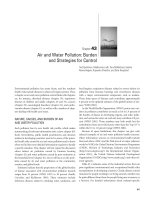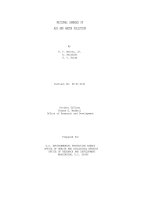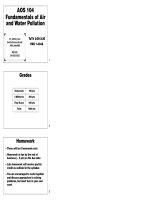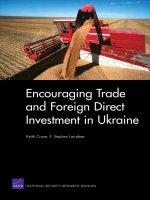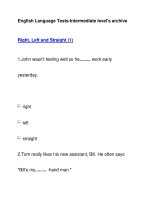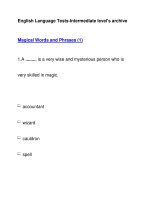earth''s land air and water
Bạn đang xem bản rút gọn của tài liệu. Xem và tải ngay bản đầy đủ của tài liệu tại đây (7.4 MB, 14 trang )
by Emily McKenzie
Scott Foresman Science 2.5
Genre Comprehension Skill Text Features Science Content
Nonfi ction Picture Clues • Labels
• Glossary
Natural
Resources
ISBN-13:
ISBN-10:
978-0-328-34218-1
0-328-34218-1
9 780328 342181
90000
Earth Science
34218_CVR_FSD Page Cover1 1/23/07 3:12:20 PM christ34218_CVR_FSD Page Cover1 1/23/07 3:12:20 PM christ /Volumes/403/sf00207_SciLR_copyright%0/sf00207_G2/sf00207_G2a_Below/34218/Volumes/403/sf00207_SciLR_copyright%0/sf00207_G2/sf00207_G2a_Below/34218
by Emily McKenzie
Scott Foresman Science 2.5
Genre Comprehension Skill Text Features Science Content
Nonfi ction Picture Clues • Labels
• Glossary
Natural
Resources
ISBN-13:
ISBN-10:
978-0-328-34218-1
0-328-34218-1
9 780328 342181
90000
Earth Science
34218_CVR_FSD Page Cover1 1/23/07 3:12:20 PM christ34218_CVR_FSD Page Cover1 1/23/07 3:12:20 PM christ /Volumes/403/sf00207_SciLR_copyright%0/sf00207_G2/sf00207_G2a_Below/34218/Volumes/403/sf00207_SciLR_copyright%0/sf00207_G2/sf00207_G2a_Below/34218
Vocabulary
boulder
erosion
minerals
natural resource
pollution
recycle
sand
weathering
What did you learn?
1. What is soil made of?
2. Name three natural resources.
3.
People need to be
careful with campfires. In your own words,
write to explain why.
4.
Picture Clues Look at the picture on
page 6. Can you point to the boulder?
Photographs: Every effort has been made to secure permission and provide appropriate credit for
photographic material. The publisher deeply regrets any omission and pledges to correct errors called to its
attention in subsequent editions. Unless otherwise acknowledged, all photographs are the property of Scott
Foresman, a division of Pearson Education. Photo locators denoted as follows: Top (T), Center (C), Bottom
(B), Left (L), Right (R) Background (Bkgd)
Opener: (TR) ©Stone/Getty Images, (Bkgd) ©Steve Terrill/Corbis, (Bkgd) ©M. Colbeck/OSF/Animals
Animals/Earth Scenes; Title Page: (Bkgd) ©Steve Terrill/Corbis 3 (T) ©Steve Terrill/Corbis, (B) ©Donna
Disario/Corbis; 4 (TR) ©Roy Morsch/Corbis, (BL) ©DK Images; 5 ©Craig Tuttle/Corbis; 6 (BR) ©DK
Images, ©Royalty-Free/Corbis; 8 ©David M. Dennis/Animals Animals/Earth Scenes; 10 (BR) ©Royalty-
Free/Corbis; 11 ©Royalty-Free/Corbis; 12 ©Grant Heilman/Grant Heilman Photography; 13 ©Lester
Lefkowitz/Corbis; 14 (B) ©Charles E. Rotker/Corbis, ©Gary Meszaros/Visuals Unlimited; 16 ©Eric
Fowke/PhotoEdit; 17 ©Pete Soloutos/Corbis; 18 (TR) ©Ryan McVay/PhotoDisc, (CC) ©Pete Soloutos/
Corbis, (BR) ©ThinkStock/SuperStock; 19 ©Steve Terrill/Corbis; 21 Digital Vision; 22 (BL) ©Phil
Schermeister/Corbis, (CR) ©Photodisc Red/Getty Images; 23 ©Momatiuk Eastcott/Animals Animals/
Earth Scenes.
ISBN 13: 978-0-328-34218-1; ISBN 10: 0-328-34218-1
Copyright © Pearson Education, Inc.
All Rights Reserved. Printed in the United States of America. This publication is
protected by Copyright and permission should be obtained from the publisher prior
to any prohibited reproduction, storage in a retrieval system, or transmission in any
form by any means, electronic, mechanical, photocopying, recording, or likewise. For
information regarding permissions, write to: Permissions Department, Scott Foresman,
1900 East Lake Avenue, Glenview, Illinois 60025.
1 2 3 4 5 6 7 8 9 10 V010 13 12 11 10 09 08 07
34218_CVR_FSD Page Sec1:2 1/23/07 3:12:25 PM christ34218_CVR_FSD Page Sec1:2 1/23/07 3:12:25 PM christ /Volumes/403/sf00207_SciLR_copyright%0/sf00207_G2/sf00207_G2a_Below/34218/Volumes/403/sf00207_SciLR_copyright%0/sf00207_G2/sf00207_G2a_Below/34218
Earth’s Land, Air, and Water
by Emily McKenzie
34218_01-24_FSD 134218_01-24_FSD 1 1/17/07 9:29:10 AM1/17/07 9:29:10 AM
2
What are natural resources?
Natural resources come from Earth.
A natural resource is something that
people can use that comes from nature.
Sun, water, and air are natural resources.
34218_01-24_FSD 234218_01-24_FSD 2 1/17/07 9:29:23 AM1/17/07 9:29:23 AM
3
Some natural resources can get used up.
Oil and coal are resources that get used up.
Some natural resources can be replaced.
We can plant new trees.
Some natural resources cannot be used up.
Sun, water, and air cannot be used up.
34218_01-24_FSD 334218_01-24_FSD 3 1/17/07 9:29:28 AM1/17/07 9:29:28 AM
4
Water and Air
Water is a natural resource.
Plants and animals need water to live.
People need water too.
People use water to drink, cook, and clean.
34218_01-24_FSD 434218_01-24_FSD 4 1/17/07 9:29:43 AM1/17/07 9:29:43 AM
5
Ponds and rivers have fresh water.
Oceans have salt water.
Air is a natural resource too.
Plants, animals, and people need air.
Wind is air that moves.
34218_01-24_FSD 534218_01-24_FSD 5 1/17/07 9:29:45 AM1/17/07 9:29:45 AM
What are rocks and soil like?
Rocks are natural resources.
Rocks can be big or small.
A boulder is a very big rock.
Wind, rain, and ice can break up rocks.
Sand is made of small pieces of rock.
People use sand to make roads.
People use rocks to make houses.
6
34218_01-24_FSD 634218_01-24_FSD 6 1/17/07 9:30:00 AM1/17/07 9:30:00 AM
7
Rocks are made up of minerals.
Minerals are a natural resource.
Gold and silver are minerals.
Quartz is a mineral.
People make glass from quartz.
Quartz
34218_01-24_FSD 734218_01-24_FSD 7 1/17/07 9:30:05 AM1/17/07 9:30:05 AM
Soil
Soil covers most of the land.
Soil is a natural resource.
Soil is made of clay, sand, and humus.
It also has air and water in it.
Some animals live in soil.
Different plants grow in different kinds
of soil.
8
34218_01-24_FSD 834218_01-24_FSD 8 1/17/07 9:30:07 AM1/17/07 9:30:07 AM
9
Sandy soil is rough and dry.
Clay soil is soft and smooth.
Humus is a part of soil that comes from
living things.
Clay
Humus
Sand
34218_01-24_FSD 934218_01-24_FSD 9 1/17/07 9:30:11 AM1/17/07 9:30:11 AM
10
How do people use plants?
Plants are natural resources.
People use plants for many things.
People use wood to build homes and to
make paper.
34218_01-24_FSD 1034218_01-24_FSD 10 1/17/07 9:30:29 AM1/17/07 9:30:29 AM
11
This T-shirt is made from a cotton plant.
People use wheat to make bread.
34218_01-24_FSD 1134218_01-24_FSD 11 1/17/07 9:30:35 AM1/17/07 9:30:35 AM
How does Earth change?
Earth changes all the time.
Water and wind move rocks and soil.
This is called erosion.
Plants can stop erosion.
Their roots keep soil in place.
12
34218_01-24_FSD 1234218_01-24_FSD 12 1/17/07 9:30:42 AM1/17/07 9:30:42 AM
Weather can change Earth.
Water can break up rocks.
This is called weathering.
Animals can change Earth.
They dig homes and break up the soil.
13
34218_01-24_FSD 1334218_01-24_FSD 13 1/17/07 9:30:50 AM1/17/07 9:30:50 AM
How can people help
protect Earth?
People can change Earth.
People can harm the land, air, and water.
This is called pollution.
14
34218_01-24_FSD 1434218_01-24_FSD 14 1/17/07 9:30:53 AM1/17/07 9:30:53 AM
1515
Pollution hurts plants and animals.
People try to stop pollution.
People want to keep Earth clean.
They want to keep plants and animals safe.
34218_01-24_FSD 1534218_01-24_FSD 15 1/17/07 9:30:57 AM1/17/07 9:30:57 AM
16
Reduce, Reuse, Recycle
Trash is a kind of pollution.
When we pick up trash, we help stop
pollution.
People can recycle trash.
To recycle means to change something
so that it can be used again.
34218_01-24_FSD 1634218_01-24_FSD 16 1/17/07 9:30:58 AM1/17/07 9:30:58 AM
17
Did you know milk cartons can be recycled?
The milk cartons in this picture were used to
make a playground!
34218_01-24_FSD 1734218_01-24_FSD 17 1/17/07 9:31:14 AM1/17/07 9:31:14 AM
18
People can reuse things to stop pollution.
To reuse means to use over and over again.
34218_01-24_FSD 1834218_01-24_FSD 18 1/17/07 9:31:21 AM1/17/07 9:31:21 AM
People can reduce the natural resources
they use.
To reduce means to use less.
19
34218_01-24_FSD 1934218_01-24_FSD 19 1/17/07 9:31:28 AM1/17/07 9:31:28 AM
Protecting Plants and Animals
People cut down trees.
Animals live in the trees.
The animals lose their homes.
People can plant new trees for the animals.
20
34218_01-24_FSD 2034218_01-24_FSD 20 1/17/07 9:31:39 AM1/17/07 9:31:39 AM
Forests change all the time.
Trees can burn in forest fires.
The wind can blow down trees.
New trees take a long time to grow back.
21
34218_01-24_FSD 2134218_01-24_FSD 21 1/17/07 9:31:42 AM1/17/07 9:31:42 AM
22
People must be careful with campfires.
Campfires can start a forest fire.
Forest fires can kill many trees and animals.
Plants and animals can also lose their homes
when people build where they live.
34218_01-24_FSD 2234218_01-24_FSD 22 1/17/07 9:31:43 AM1/17/07 9:31:43 AM
A refuge is a safe place for plants
and animals.
People can visit a refuge and enjoy all the
plants and animals living in it.
Earth gives us many natural resources.
Let’s enjoy them and help keep them safe!
23
34218_01-24_FSD 2334218_01-24_FSD 23 1/17/07 9:31:46 AM1/17/07 9:31:46 AM
24
Glossary
boulder a large rock
erosion when wind and rain move
soil
minerals natural resources that make
up rocks
natural resource something people use that
comes from nature
pollution putting harmful things into
the water, air, or land
recycle to change something so it
can be used again
sand small pieces of rock
weathering when water or temperature
change the land
34218_01-24_FSD 2434218_01-24_FSD 24 1/17/07 9:31:50 AM1/17/07 9:31:50 AM
Vocabulary
boulder
erosion
minerals
natural resource
pollution
recycle
sand
weathering
What did you learn?
1. What is soil made of?
2. Name three natural resources.
3.
People need to be
careful with campfires. In your own words,
write to explain why.
4.
Picture Clues Look at the picture on
page 6. Can you point to the boulder?
Photographs: Every effort has been made to secure permission and provide appropriate credit for
photographic material. The publisher deeply regrets any omission and pledges to correct errors called to its
attention in subsequent editions. Unless otherwise acknowledged, all photographs are the property of Scott
Foresman, a division of Pearson Education. Photo locators denoted as follows: Top (T), Center (C), Bottom
(B), Left (L), Right (R) Background (Bkgd)
Opener: (TR) ©Stone/Getty Images, (Bkgd) ©Steve Terrill/Corbis, (Bkgd) ©M. Colbeck/OSF/Animals
Animals/Earth Scenes; Title Page: (Bkgd) ©Steve Terrill/Corbis 3 (T) ©Steve Terrill/Corbis, (B) ©Donna
Disario/Corbis; 4 (TR) ©Roy Morsch/Corbis, (BL) ©DK Images; 5 ©Craig Tuttle/Corbis; 6 (BR) ©DK
Images, ©Royalty-Free/Corbis; 8 ©David M. Dennis/Animals Animals/Earth Scenes; 10 (BR) ©Royalty-
Free/Corbis; 11 ©Royalty-Free/Corbis; 12 ©Grant Heilman/Grant Heilman Photography; 13 ©Lester
Lefkowitz/Corbis; 14 (B) ©Charles E. Rotker/Corbis, ©Gary Meszaros/Visuals Unlimited; 16 ©Eric
Fowke/PhotoEdit; 17 ©Pete Soloutos/Corbis; 18 (TR) ©Ryan McVay/PhotoDisc, (CC) ©Pete Soloutos/
Corbis, (BR) ©ThinkStock/SuperStock; 19 ©Steve Terrill/Corbis; 21 Digital Vision; 22 (BL) ©Phil
Schermeister/Corbis, (CR) ©Photodisc Red/Getty Images; 23 ©Momatiuk Eastcott/Animals Animals/
Earth Scenes.
ISBN 13: 978-0-328-34218-1; ISBN 10: 0-328-34218-1
Copyright © Pearson Education, Inc.
All Rights Reserved. Printed in the United States of America. This publication is
protected by Copyright and permission should be obtained from the publisher prior
to any prohibited reproduction, storage in a retrieval system, or transmission in any
form by any means, electronic, mechanical, photocopying, recording, or likewise. For
information regarding permissions, write to: Permissions Department, Scott Foresman,
1900 East Lake Avenue, Glenview, Illinois 60025.
1 2 3 4 5 6 7 8 9 10 V010 13 12 11 10 09 08 07
34218_CVR_FSD Page Sec1:2 1/23/07 3:12:25 PM christ34218_CVR_FSD Page Sec1:2 1/23/07 3:12:25 PM christ /Volumes/403/sf00207_SciLR_copyright%0/sf00207_G2/sf00207_G2a_Below/34218/Volumes/403/sf00207_SciLR_copyright%0/sf00207_G2/sf00207_G2a_Below/34218

